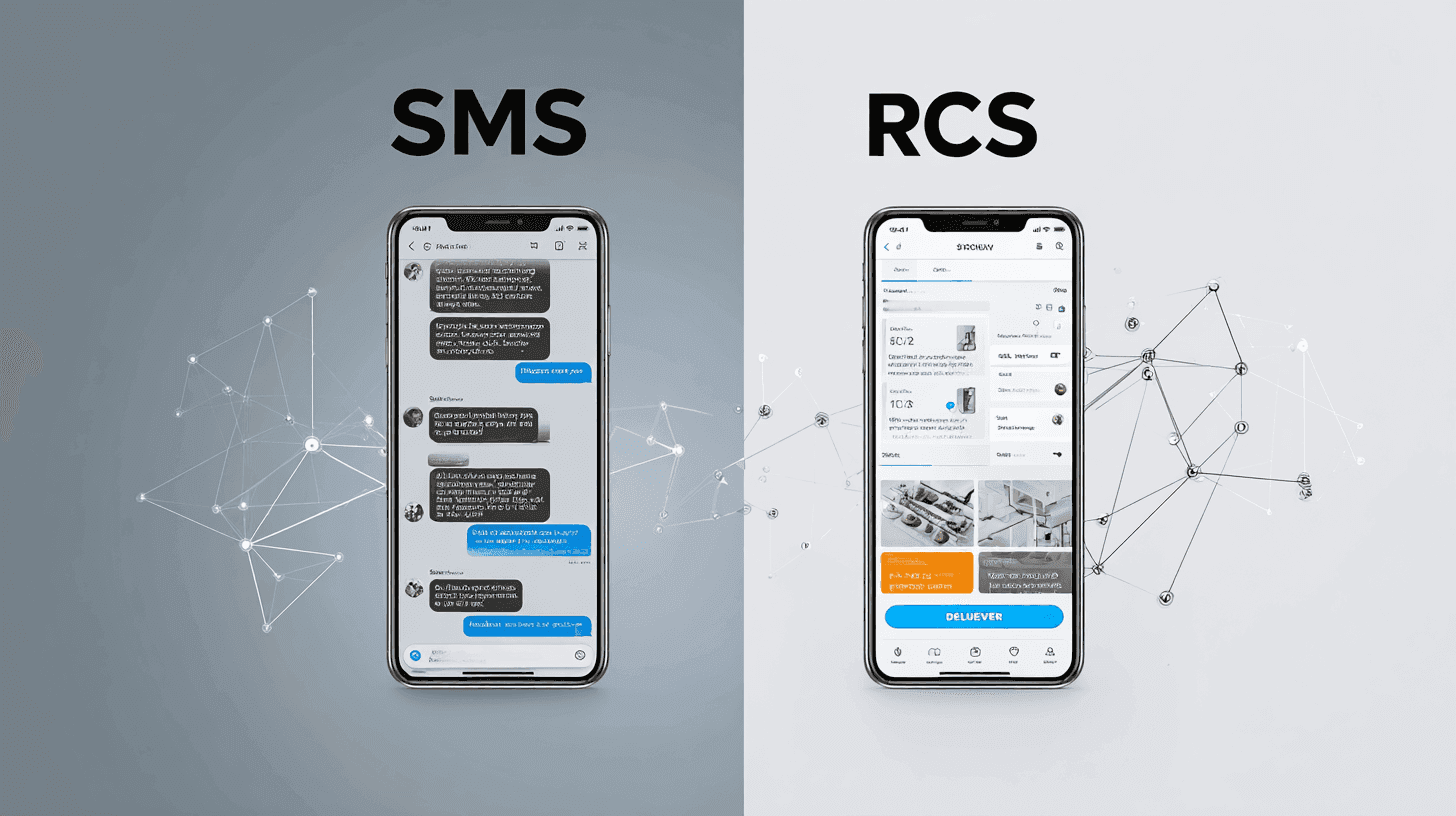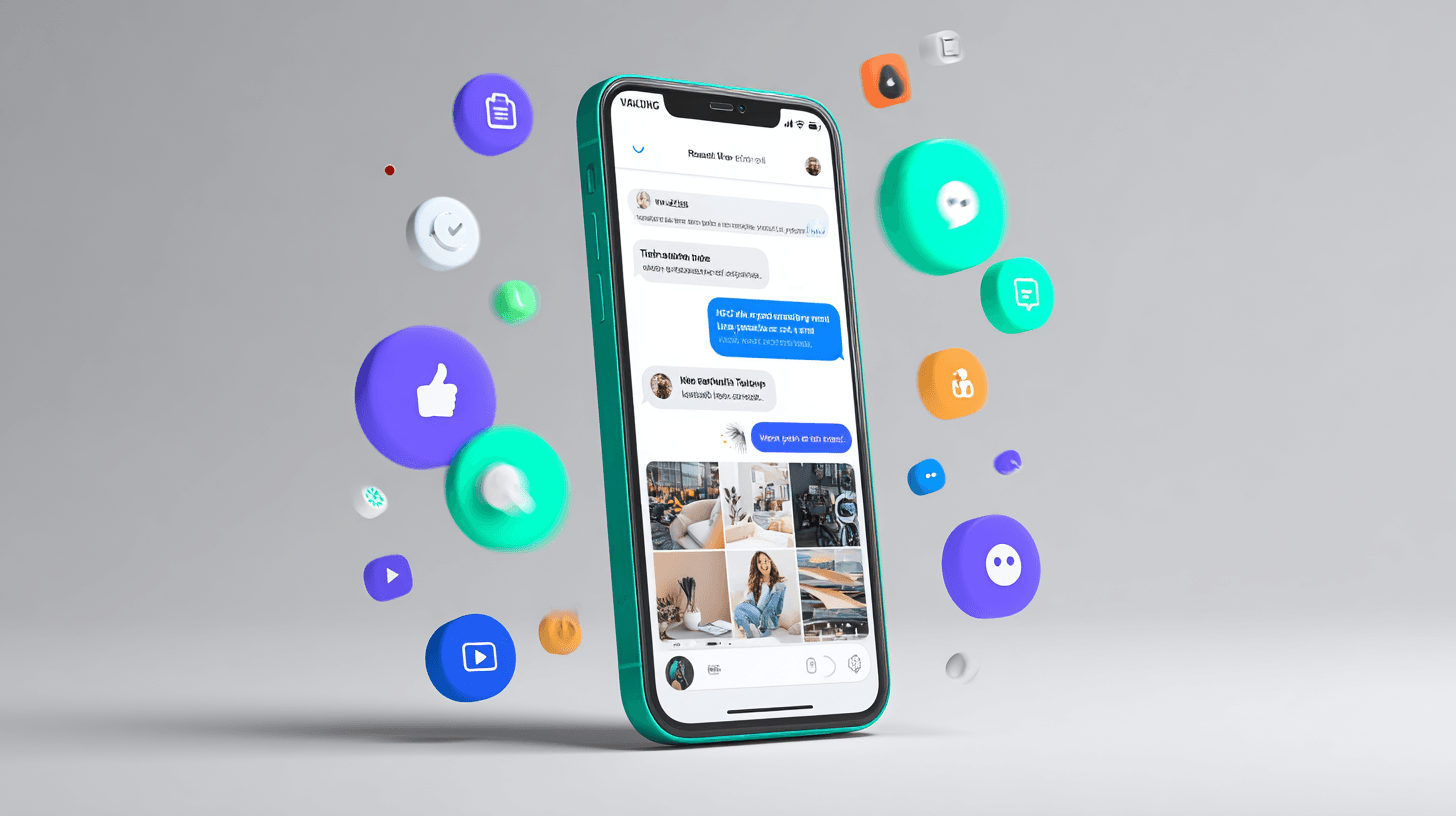RCS vs SMS – The technological shift is changing how companies communicate with customers. Even though classic SMS (Short Message Service) still runs on every mobile phone as a universal standard, RCS (Rich Communication Services) today offers everything brands, e-commerce managers, and agencies need for direct, effective dialogue. Decision-makers who now rely on future-proof messaging services gain a clear competitive advantage.
What’s behind SMS and RCS in detail?
SMS (Short Message Service): The universal standard
Since the 1990s, SMS has been the epitome of digital short communication – it works on every device, requires no app, and always runs over the mobile network. It guarantees maximum reach but is heavily limited: 160 characters, no media options, no read receipts, no interactive elements. Especially in marketing, customer service, and support, companies quickly hit the limits. MMS, intended as SMS’s successor (for media transmission), never really gained traction – too expensive, too complex, technically inconsistent.
RCS (Rich Communication Services): The SMS successor in the messaging era
RCS Chat pushes messaging services to the level of modern messenger apps. Instead of mere text messages, it enables multimedia support, chat features, groups, emojis, read receipts, interactivity, and reliable distribution directly via the messages app (e.g., Google Messages on Android, increasingly also iOS). RCS messages run over a fast data connection, integrate into existing apps, and create new options for real-time communication and modern UX in customer contact.
Key differences between RCS and SMS
Rich media vs. text only
While SMS consists exclusively of plain text messages, RCS enables the sending of multimedia messages with images, videos, voice messages, files, and locations – directly in the default messages app. This makes exchanges significantly more modern and interactive, similar to WhatsApp or Telegram.
Read receipts & delivery reports
RCS offers read receipts, typing indicators (“… is typing”), and delivery status, which are not technically provided with classic SMS. Users can see in real time whether a message has arrived or been read.
Costs & infrastructure
SMS are sent over the provider’s mobile network and are often billed per message. RCS, by contrast, uses the internet connection (Wi-Fi or mobile data) – sending is therefore generally free as long as an active data connection exists.
Security & data protection
While SMS offers no encryption, RCS supports end-to-end encryption (in Google Messages) and uses modern authentication methods. This ensures significantly more data protection and security compared to the outdated SMS protocol.
Advantages of RCS for businesses and e-commerce
Automated customer communication
RCS enables companies to interact directly with customers via chatbots and AI-powered systems – automated, personalized, and in real time. Typical use cases include shipping notifications, appointment confirmations, or support dialogues. This creates efficient, scalable customer communication directly in the smartphone’s native messaging channel.
Better user experience (images, buttons, product info)
Unlike plain SMS, companies can send visual content via RCS such as product images, videos, buttons, and interactive menus. This makes the dialogue more informative and intuitive – for example with “Buy now” buttons, integrated product galleries, or location links. This increases conversion rates and strengthens brand perception.
Campaign tracking and conversion
RCS offers detailed analytics: companies can see when messages were opened or buttons clicked. This data flows into the marketing and CRM system and enables data-driven campaign tracking, better segmentation, and targeted optimization of future actions – a clear advantage over classic SMS.
RCS vs SMS – The quick comparison: features, technology & reach
| Feature | SMS | RCS |
|---|---|---|
| Text length | 160 characters | Up to 8,000 characters |
| Multimedia support | Limited (images only via MMS, often expensive) | Images, videos, files, GIFs, voice messages |
| Chat features | Not available | Read receipts, emojis, groups, buttons |
| Interactive elements | No | Yes (buttons, product tiles, links) |
| Encryption | Low (no end-to-end encryption) | End-to-end encryption (partly) |
| Network & connection | Mobile network, always available | Data connection (Wi-Fi, 4G, 5G) required |
| Device compatibility | Universal (every mobile phone, iOS, Android) | Smartphones with RCS support, Messages app |
| Cost model | Per SMS/MMS, depending on volume & provider | Data plan, often cheaper, Wi-Fi free |
| Analytics & tracking | No evaluation possible | Measurable, tracking & feedback options |
Data protection & security: How do SMS and RCS compare on encryption?
- SMS: Transmission in plain text, no end-to-end encryption, no GDPR-compliant protection mechanisms. Not suitable for sensitive data.
- RCS: Modern RCS messaging platforms (such as Google Messages, Chatarmin) partly offer end-to-end encryption and secure data transmission. For compliance and GDPR, the provider/network operator sets the standard.
Best practice: Always check whether the messaging solution used transmits RCS messages securely and in encrypted form – Chatarmin guarantees this as a platform feature for companies and agencies.
Chatarmin as a service
With Chatarmin, you can seamlessly combine RCS and WhatsApp – for customer-centric service, automated communication, and targeted marketing. The platform unites both messaging worlds and enables centralized management of RCS chats, WhatsApp messages, and classic SMS in a single interface.
Thanks to GDPR-compliant EU hosting and short implementation times, Chatarmin is particularly attractive for e-commerce companies, brands, and agencies looking for quickly scalable, secure communication solutions.
Examples of RCS applications with Chatarmin:
- Shipping confirmations and delivery updates directly in the chat with tracking link
- Returns management, automated via RCS or WhatsApp
- Personalized campaigns, e.g., product recommendations or discount promotions with interactive buttons
In this way, Chatarmin creates omnichannel communication that noticeably increases reach, efficiency, and customer satisfaction – all in a single, intelligent system.
Conclusion & recommendation
While SMS continues to provide baseline reach, RCS sets new standards in engagement, multimedia, and interactivity. Companies, e-commerce managers, and agencies that now adopt flexible messaging services like RCS (and platforms like Chatarmin) achieve more leads, better customer retention, and higher efficiency.
The clear recommendation: use RCS as the new messaging standard, combine both channels (SMS & RCS) for maximum reach, and secure innovative chat features for marketing, service, and sales – GDPR-compliant and easy to integrate.
FAQ: Frequently asked questions about RCS vs SMS
1. What is the main difference between RCS - SMS?
SMS is text-based, works everywhere, but offers only minimal functionality. RCS expands the messages app with multimedia, chat features (read receipts, groups), interactivity, and more security – similar to WhatsApp or iMessage.
2. Which devices support RCS messaging?
RCS runs on all modern Android smartphones with the Google Messages app as well as increasingly on iOS devices (since September 2024). SMS continues to work universally, even on older phones and without an app.
3. Is RCS as secure as WhatsApp?
RCS messages (depending on app and mobile provider) partly offer end-to-end encryption. Modern platforms like Chatarmin and Google Messages transmit data in a GDPR-compliant manner with improved protection mechanisms compared to classic SMS.
4. Does the recipient need to install a special app for RCS?
No, RCS is usually integrated directly into the default messages app. Usage is simple and self-explanatory for end customers.
5. How should a company choose between SMS and RCS?
Providers like Chatarmin intelligently choose the appropriate channel depending on the recipient’s device, network, and reach – SMS for maximum baseline reach, RCS for all modern chat features and multimedia communication. This way, you reach every customer optimally.
6. What role does Chatarmin play in managing RCS and SMS?
Chatarmin connects RCS, SMS, WhatsApp, and other messengers in a GDPR-secure platform – for marketing, campaigns, and customer service. This lets you reach your target audience across all channels from a single source.
Ready for efficient, modern customer communication?
Test Chatarmin – the central messaging suite for RCS, SMS, WhatsApp, and all other channels. Start now and secure interaction, conversion & customer proximity at the cutting edge – simple, secure, scalable!





![Create a WhatsApp channel: How to set up your WhatsApp Channel [Instructions and Tips 2025]](https://blogfiles-chatarmin.s3.eu-central-1.amazonaws.com/whatsapp_channels_by_META_7f5ef6d9bd.jpg)


